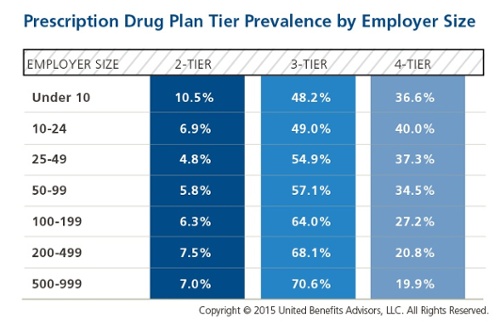By Bill Olson
Chief Marketing Officer at United Benefit Advisors
 Most employers have been using multi-tier prescription drug plans for many years, but new data released from the 2014 UBA Health Plan Survey shows a significant increase in the use of 4-tier plans, which typically cover the highest cost drugs, as well as major increases in corresponding median copays – a trend that is expected to continue.
Most employers have been using multi-tier prescription drug plans for many years, but new data released from the 2014 UBA Health Plan Survey shows a significant increase in the use of 4-tier plans, which typically cover the highest cost drugs, as well as major increases in corresponding median copays – a trend that is expected to continue.
UBA’s survey finds that, since 2009, the number of 4-tier plans has grown from 13.6 percent to 32.9 percent of all plans offered, a 141.9 percent increase. Since 2012, tier 4 median copays have also grown 25 percent; in 2014, 4-tier plans had median copays of $10, $35, $55 and $100.
According to UBA’s survey, 57.1 percent of all prescription drug plans utilize three tiers (generic, formulary brand, and non-formulary brand), 6.8 percent retain a 2-tier plan, and 32.9 percent offer four tiers or more. In five years (since 2009), the number of 3-tier plans has decreased 20.4 percent (from 71.7 percent to 57.1 percent) and 2-tier plans have decreased 45.6 percent (from 12.5 percent to 6.8 percent) in that same time period.
- Employer size with the most 3-tier plans: employers with 500 to 999 employees (70%)
- Employer size with the least 3-tier plans: employers with fewer than 10 employees (48.2%)
- Employer size with the most 4-tier plans: employers with 10 to 24 employees (40%)
- Employer size with the least 4-tier plans: employers with 500 to 999 employees (20%)
Read UBA’s full press release including the latest commentary from UBA Partners on these trends.
Get the most up-to-date trends in pharmacy copay design.
Download the UBA Health Plan Survey Executive Summary with complete findings on plan design and costs by region, industry and employer size.

